With the many choices, how do you pick the best work gloves for winter? In this article, find out what features to look at when choosing work gloves for your staff

Working in an industrial or commercial worksite already has its share of hazards, particularly for workers’ hands. While it can be challenging enough to protect workers’ hands at the workplace, the safety measures they will have to take can become more complicated during the winter season.
In this guide, Canadian Occupational Safety will discuss winter work gloves. We’ll cover their function, safety requirements, how to choose the best work gloves for winter in Canada. We’ll also share examples of the best work winter gloves on the market for your staff to stay warm and protected.
Canada’s best work gloves for winter
As with many different types of gloves or PPEs, there’s a huge selection of winter work gloves to choose from to recommend to your staff. These are some of the best:

1. Magid ROC Hi-Viz Thermal Coated Work Gloves
Price: $6.40 per pair
A prominent manufacturer of PPEs and other safety equipment, Magid has since expanded its line of work gloves to include those for cold weather. The ROC Hi-Viz Thermal Coated Work Gloves combine cut and impact resistance with insulation to give workers protection, comfort, and even visibility when working out in the cold.
Here are some of its most prominent features:
- patented thermal lining protects against cold temperatures
- durable shell provides breathability, comfort, and 360-degree cut protection special coating ensures a secure grip in wet, dry, or oily applications
- ANSI Level A2 cut resistance, ANSI Level 3 puncture resistance, and ANSI Level 4 abrasion resistance
- machine washable for longer service life
- comes in a highly visible colour that enhances worker protection and compliance
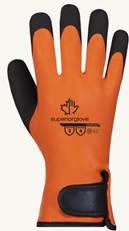
2. Superior Glove Chemstop F225FLNV
Price: $245.28 for a 12-pack or $16.27 per pair
Chemstop from quality outfitter Superior Glove is an all-weather work glove that performs well even in low-temperature weather and conditions.
The Superior Glove Chemstop F225FLNV chemical-resistant gloves feature a hook-and-loop wrist closure for a snug fit that prevents weather elements from seeping in. The gloves are lined with fleece to keep hands warm down to 0°C / 32°F while the textured nitrile palms offer better grip, even in wet conditions.
Superior Glove claims that the Chemstop F225FLNV’s vinyl body helps resist chemicals and oils. It's ideal for work in:
- cold storage
- construction
- fishing
- materials handling
Superior Glove was one of our Readers’ Choice 2023 awardees for best safety suppliers under the PPE – hand protection category.
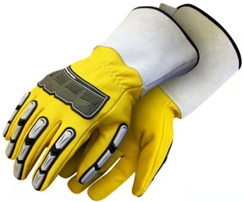
3. Bob Dale Specialty Impact Series
Price: $40.80 a pair
Another quality manufacturer of work gloves, Bob Dale offers an entire line that they proudly tout as the “next generation of professional work gloves". They offer increased protection and greater flexibility to let workers work safely and fast.
The Bob Dale specialty impact series features heavy rubber padded back hand and fingers for protection against abrasion and impact, along with vibration absorption and grip.
For dexterity and durability, they also feature grain goat skin leather. Among the best work gloves for winter, the product is also versatile. It can be purchased with or without a leather gauntlet cuff and lining.

4. Endura Deluxe 365 DLX2 Winter Glove with WaterStop
Price range: $44.06 to $48.95
These winter work gloves offer good protection against the cold while also contributing to safety with the high visibility retro-reflective stripes. These gloves provide a firm grip, thanks to its cowhide construction and Kevlar sewing thread that reinforces seam integrity.
The Endura Deluxe 365 DLX2 features WaterStop, a patented technology that provides a high level of water, oil, and stain resistance so the gloves can be used in a variety of heavy-duty tasks. These gloves also feature a high-performance thumb and palm patch for extended product life and greater cost efficiency.
.jpeg)
5. Emerald CX Cut-Resistant Kevlar/Steel Winter Glove with PVC Palm
Price: $24.50 to $28.99 per pair; $23.41 per pair if purchased per dozen
These winter work gloves are a good choice for working with cutting tools in frigid environments. The Emerald CX cut-resistant winter gloves with PVC palm have a puncture resistance rating of level 3, an abrasion resistance of level 4 and a cut resistance of level A5, meeting ASTM and ANSI standards.
For its thermal protection, the Emerald CX has a resistance to convective cold of 1/4, a 2/4 level resistance to contact cold. It is also waterproof. These winter work gloves are the best for conditions where the ambient temperature is at -5° C (23° F).
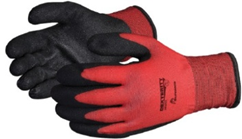
6. Dexterity Winter Gloves with PVC Coating
Price range: $40.04 to $53.91 per pair
As the name implies, this pair of winter work gloves afford the user with optimal dexterity while keeping their hands dry in wintry or wet conditions. Users of the Dexterity Winter Gloves will not lack for warmth and comfort, thanks to its fleece lining.
The gloves' PVC palm coating with micropores ensures flexibility even in sub-zero temperatures and a firm grip in both wet and dry conditions. The material is also lightweight and dries quickly, protecting workers’ hands from thermal injury while ensuring comfort throughout their shift.
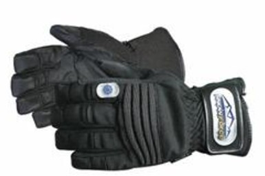
7. SnowForce SNOW388VM General Purpose Gloves
Price: $54.32 per pair
These are insulated gloves designed to protect workers’ hands from extreme cold temperatures down to -30°C (-22°F). This makes the SnowForce General Purpose Gloves ideal for tasks where cold is the main hazard. With a gauntlet-style cuff, the winter work gloves also have three layers of insulation that provide warmth with minimum bulk in the harshest of climates.
The wearer does not have to worry about water seeping in or cold draughts, as its waterproof and breathable inserts lock them out. Velcro tabs and wrist elastics give a snug fit. There are anti-slip PVC patches on the palm and fingertips to ensure the wearer never loses their grip in wet conditions.
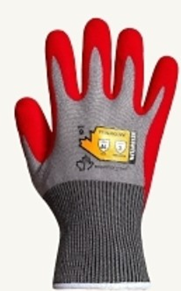
8. TenActiv Waterproof Cut-Resistant Glove
Price: $41.47 per pair
These winter work gloves are waterproof. With its acrylic terry liner, the TenActiv Waterproof Cut-Resistant glove provides a high level of warmth with minimal bulk.
It can keep hands warm in temperatures down to as low as -10°C (14°F). The winter work gloves combination nitrile palm coating and laminated waterproof membrane makes them the best for handling soaked or oil-slicked parts.
The gloves also feature the patented TenActiv knit, providing ANSI Level A4 cut protection. They also come with a reinforced thumb crotch that prolongs their lifespan by reducing wear in high-stress areas.

9. Ironclad Tundra Work Glove
Price: $219.99 per for six pairs or $36.67 per pair
These gloves are designed for working in extreme cold weather environments. One of the product's unique features is they have touchscreen-compatible fingertips, apart from being waterproof.
The Cryoflex shell gives its waterproof properties and is designed to fit like a ski glove. With thick insulative material weighing 200g, the Ironclad Tundra is effective at keeping user’s hands warm at 0°F. For durability, these winter work gloves have a reinforced Duraclad palm and Kevlar-reinforced thumb saddle. These materials ensure greater durability in high-wear areas.
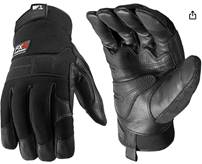
10. Wells Lamont FX3 Men's HydraHyde Leather Palm Winter Work Gloves
Price: $27.94 per pair
These leather winter work gloves offers water resistance, flexibility, warmth, and durability. The palm is made of patented HydraHyde leather, which offers high water resistance and helps keep hands dry in wet conditions.
To protect the wearer from the cold, the Wells Lamont FX3 has 70-gram Thinsulate insulation by 3M. This material provides excellent warmth without making the gloves excessively bulky.
These gloves feature a spandex back that allows for both breathability and flexibility, so the wearer enjoys a comfortable fit along with a full range of motion. There’s also a reinforced palm patch and thumb saddle for greater resistance against wear in high-stress areas to increase the gloves' durability.
The basics behind the best work gloves for winter
While it is unlikely that your staff will encounter extreme cold conditions, the average temperatures during winter in Canada still call for gloves that will protect and keep your workers’ hands safe and warm.
Depending on the type of work that your staff needs to do, they will need work gloves that provide:
- some abrasion and cut resistance
- warmth
- insulation or protection from the cold
- waterproofing
- enhanced visibility (optional)
Canada is renowned for extremely cold winters, and regions that are farthest from open water are the coldest. Regardless of where your worksite is, it makes sense to provide your workers with the best winter work gloves that your company can afford.
Top features to consider when buying the best work gloves for winter
What should you look for when purchasing winter work gloves for your workers? First, making sure your staff each gets a pair of gloves to help keep their hands warm while working is top priority.
Handling cold tools or materials with thin gloves, in the winter especially, is a definite no-no. Working in extreme cold conditions opens your staff up to a range of cold-related injuries, and this is not something anyone would want.
These are the crucial qualities to check and look out for when outfitting your staff with winter work gloves:
1. Insulation
This should be a top priority when looking for the best work gloves for winter. If your staff will be working in subzero temperatures, insulation is their best bet for protection against the ravages of cold conditions – like frostbite and nonfreezing cold injuries (NFCI).
2. Grip capacity
As with many types of regular work gloves, gripping capacity is another attribute to look for when choosing the best work gloves for winter. Manufacturers usually design the gloves with leather palms or incorporate a special palm coating to improve grip.
If the glove manufacturers choose the coating route, they would typically coat the palm areas of their gloves with either polyurethane (PU) or nitrile. PU is often the more common coating used on regular work gloves, as this is more dexterous and allows for increased grip.
For cold conditions, however, nitrile coating is the prime choice. Gloves with this coating offer increased warmth and protection for workers’ hands. Nitrile coating is also waterproof, insulating the user and further protecting workers’ hands from frostbite.
You may encounter winter work gloves with these coatings:
- nitrile
- foam nitrile
- rubber
- HPT
- latex
- PVC
When it comes to choosing gloves based on grip capacity, think about the nature of the work. Choose gloves that offer a balance between dexterity and grip, as these are two important qualities needed for working safely in frigid conditions.
3. Cut resistance
If there is a risk of your workers sustaining cuts, the best winter work gloves for them would have these qualities:
- excellent grip
- great dexterity
- a degree of cut resistance (no glove or glove material provides 100% resistance to cutting)
Canada recently adopted the American National Standards Institute (ANSI) when it comes to cut resistance. You can refer to the ANSI standard as a guide when determining the cut resistance of your winter work gloves.
While there are cut-resistant gloves that can protect against injuries, choosing winter work gloves for their cut resistance alone is not advisable. Cut-resistant gloves are made of materials that prioritize protection against cutting, not from cold conditions. Some cut-resistant gloves may even be made of materials like steel or chainmail that worsen the effects of the cold.
Choose a pair of winter work gloves that give some cut resistance without sacrificing insulation, gripping capacity, and dexterity of the user.
4. Impact resistance
Depending on the worksite and nature of the job, impact injuries can also be a major concern when choosing winter work gloves. When choosing the appropriate work gloves and determining their impact resistance, there are two sets of standards that can apply:
The European Impact Resistance Standard EN388
Canadian companies have adopted the European standards for abrasion, tear, impact, and puncture resistance (EN388) when it comes to work gloves.
Consider this standard as well to ensure your staff gets the best protection from their winter work gloves. When it comes to impact resistance and EN388, there is no in-between. Work gloves rated against EN388 mean that they will either provide impact resistance or won’t.
The American National Standards Institute (ANSI) ANSI/ISEA 138
Another Canadian adaptation of US standards is the ANSI/ISEA 138, governing impact resistance standards for work gloves. This standard was first drafted in 2019 to address the gaps in evaluating performance of work gloves’ dorsal (back of the hand) protection.
What sets this standard apart from EN388 is that its evaluation of impact resistance is more forgiving, and rates impact resistance as three different levels:
- Level 1 – Lowest impact protection
- Level 2 – Medium impact protection
- Level 3 – Highest impact protection
Although a pair of winter work gloves looks impact-resistant, this doesn’t mean that they are. Always check the rating markings of ANSI/ISEA 138 and look for the symbol that shows its impact resistance rating from levels 1 to 3. This marking is often found on the gloves themselves or is attached to the gloves.
5. Level of activity
This is an often-overlooked characteristic when it comes to choosing the best extreme weather work gloves for your staff. Think of the level of activity that your staff members or workforce will be doing, as this can greatly influence the levels of warmth, dexterity, grip, and protection they’ll need.
For instance, a worker whose job is to warn oncoming traffic of work on underground cables will need winter work gloves that provide good protection and warmth. Meanwhile, a worker who is down in the tunnels will need gloves with moisture wicking and water-resistant features to keep their hands dry. They may also need gloves that are touchscreen compatible if they are using equipment with touchscreen capabilities.
Some of the qualities you must consider for picking the best winter work gloves can apply to the other PPEs you will have to get for your workforce. It’s also sound practice to find gloves that have a snug fit and complement the other PPEs that your staff will need to perform their best in your industry.
Why are winter work gloves important?
Winter work gloves are crucial for those who work in jobs or industries that expose staff to the rigours and dangers of low temperatures. Using the right gloves to keep warm can help prevent these injuries:
1. Protection against non-freezing cold injuries (NCFIs)
This is the modern name of a common injury in World War I known as Trench Foot. NFCIs are caused by prolonged exposure to moisture, cold, or both. While NFCIs are an affliction of the foot, it’s not uncommon for NFCIs to affect the fingers and hands.
NFCI symptoms can be difficult to detect. The injury also has several stages, which can transition gradually or suddenly.
In general, NFCI sufferers will experience a loss of sensation in their feet or hands. This loss of feeling can last for over 30 minutes. If the person then tries to rewarm the affected body part, they can feel intense pain or an abnormal sensation. The affected area can also turn yellowish or reddish and swollen, and cause significant, long-lasting pain.
Left untreated, NFCI patients can suffer from permanent blood vessel and nerve damage. Fortunately, cases of NFCI are curable if mild.
2. Protection against frostbite
Frostbite can be confused with NFCIs. The main difference between them is that frostbite is the result of prolonged or repeated exposure to subzero temperatures. Subfreezing, cold ambient air is one of the main culprits of frostbite, which is why wearing the best work gloves for winter is necessary.
It’s not unusual for both NFCI and frostbite to afflict a person’s hands and feet, making diagnosis complicated. As with NFCI, a patient’s skin can appear pale, although frostbite makes the skin appear waxy and feel stiff.
The signs that confirm frostbite come out usually after the afflicted hands or feet are warmed. These symptoms can include:
- hyperemic skin, i.e. the area has more blood flow than usual, making it appear bruised
- swelling of the affected area
- blister formations in the affected area after 24 hours from thawing
- cyanotic skin – the skin turns a bluish or purplish colour, indicating a lack of oxygen in the blood present in that area
- a clear and distinct difference between afflicted and unafflicted areas of the feet, hands, or fingers
In the offhand chance that one of your staff is at risk of frostbite, do these first aid measures, then seek medical attention:
Deciding on the best work gloves for winter for your team
These are a small sample of some of the best winter work gloves you can find on the market today. Don’t limit yourself to these choices and search for other reputable brands and models. You can also pore through our Readers' Choice 2024 page for the best suppliers.
Ensuring hand protection is not a seasonal activity. Read our guide on how to ensure your staff get the best hand protection year-round.
Which of the best work gloves for winter are you considering outfitting your staff with? Let us know in the comments





